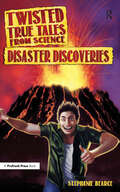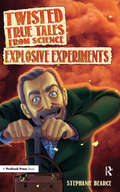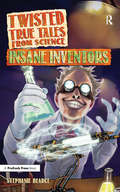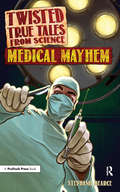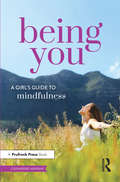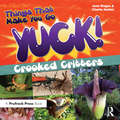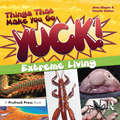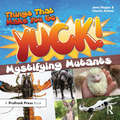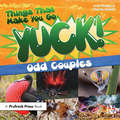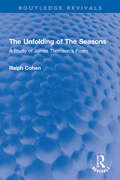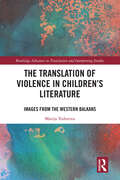- Table View
- List View
Twisted True Tales From Science: Disaster Discoveries
by Stephanie BearceLondon was once covered in a fog so polluted that it killed 12,000 people. The Aleppo earthquake killed 230,000 people, and a wall of water mysteriously wiped out the whole town of Burnham-on-Sea. All of these were catastrophic disasters, but they led to important discoveries in science. Learn about how the earth turned to liquid in New Zealand and what happens when a tsunami meets a nuclear reactor. These stories may sound twisted and strange, but they are all true tales from science!Ages 9-12
Twisted True Tales From Science: Explosive Experiments
by Stephanie BearceTwo thousand years ago, Chinese scientists were looking for a medicine that would make them live forever. Instead, they blew up their lab and discovered gunpowder. Alfred Nobel blew up his laboratory twice before he discovered the formula for dynamite. Learn about the Apollo 13 and Challenger explosions and the strange space explosions caused by top secret Starfish Prime. These stories may sound twisted, but they're all true tales from science!Ages 9-12
Twisted True Tales From Science: Insane Inventors
by Stephanie BearceNikola Tesla was crazy smart. He invented the idea for cell phones in 1893, discovered alternating current, and invented a death ray gun. Of course, he also talked to pigeons, ate only boiled food, and was scared of women who wore jewelry. He was an insane inventor. So was Henry Cavendish, who discovered hydrogen, calculated the density of the Earth, and was so scared of people that he had to write notes to communicate. Sir Isaac Newton discovered the laws of gravity, believed in magic, and thought he could make a potion to create gold. These stories may sound twisted, but they're all true tales from science!Ages 9-12
Twisted True Tales From Science: Medical Mayhem
by Stephanie BearceGround-up mummy bones, leeches sucking human blood, and a breakfast of dried mouse paste. It sounds like a horror movie, but those were actual medicines prescribed by early doctors. Medical students studied anatomy on bodies stolen from graves and had to operate on people while they were awake. Learn about the medicines that came from poison and doctors who experimented on themselves and their families. It's a twisted tale of medical mayhem, but it's all true!Ages 9-12
Being You: A Girl's Guide to Mindfulness
by Catharine HannayDo you ever feel stressed, anxious, or overwhelmed? As a teen girl, you're under a lot of pressure. Mindfulness can help. Being You explores mindfulness as a simple but powerful way to center oneself and tap into one's own inner wisdom and strength. This book:
Things That Make You Go Yuck!: Crooked Critters
by Jennifer Dlugos Charlie HattonNature doesn't always play nice, and Things That Make You Go Yuck!: Crooked Critters showcases some of the worst offenders in the plant and animal kingdoms. You'll meet trespassing toads, insects in disguise, brood-borrowing cuckoos, and many more. It's a rogue's gallery of some of nature's roughest, meanest species. Whether it's nature's slimiest organisms or the weirdest mutations, Things That Make You Go Yuck! celebrates survival of the fittest, grossest, craziest, and creepiest things in nature, proving once and for all that life in the wild is anything but ordinary.Ages 9-12
Things That Make You Go Yuck!: Extreme Living
by Jennifer Dlugos Charlie HattonLife isn't always easy, but some organisms take hard living to the extreme. Things That Make You Go Yuck!: Extreme Living looks at organisms living in the weirdest of ways: swimming miles deep in the ocean, freezing on icy mountaintops, boiling in hot springs, or even floating in space. You'll also find critters bigger, smaller, softer, longer, and stretchier than you ever thought possible. Whether it's nature's slimiest organisms or the weirdest mutations, Things That Make You Go Yuck! celebrates survival of the fittest, grossest, craziest, and creepiest things in nature, proving once and for all that life in the wild is anything but ordinary.Ages 9-12
Things That Make You Go Yuck!: Mystifying Mutants
by Jennifer Dlugos Charlie HattonHexapus. Singing mice. Spider worm. They sound like creatures from horror movies, but they are all real-life mutants that creep, crawl, and slither among us. In Things That Make You Go Yuck!: Mystifying Mutants, you'll learn that genes can be a freaky and fascinating business. From two-toned lobsters to hairless cats, this book showcases the strangest and most shocking genetic mutants in the plant and animal kingdoms. Whether it's nature's slimiest organisms or the weirdest mutations, Things That Make You Go Yuck! celebrates survival of the fittest, grossest, craziest, and creepiest things in nature, proving once and for all that life in the wild is anything but ordinary.Ages 9-12
Things That Make You Go Yuck!: Odd Couples
by Jennifer Dlugos Charlie HattonIt takes two to tango—but in the wild, two can do much crazier things than dance. In Things That Make You Go Yuck!: Odd Couples, you'll find out about nature's strangest dating rituals, cooperative couples, and parasitic pests. You'll explore symbiotic pairings like crabs that carry sea urchins on their backs, and hybrid “franken-species” that seem like something out of a science-fiction tale. Whether it's nature's slimiest organisms or the weirdest mutations, Things That Make You Go Yuck! celebrates survival of the fittest, grossest, craziest, and creepiest things in nature, proving once and for all that life in the wild is anything but ordinary.Ages 9-12
Twisted True Tales From Science: Disaster Discoveries
by Stephanie BearceLondon was once covered in a fog so polluted that it killed 12,000 people. The Aleppo earthquake killed 230,000 people, and a wall of water mysteriously wiped out the whole town of Burnham-on-Sea. All of these were catastrophic disasters, but they led to important discoveries in science. Learn about how the earth turned to liquid in New Zealand and what happens when a tsunami meets a nuclear reactor. These stories may sound twisted and strange, but they are all true tales from science!Ages 9-12
Twisted True Tales From Science: Explosive Experiments
by Stephanie BearceTwo thousand years ago, Chinese scientists were looking for a medicine that would make them live forever. Instead, they blew up their lab and discovered gunpowder. Alfred Nobel blew up his laboratory twice before he discovered the formula for dynamite. Learn about the Apollo 13 and Challenger explosions and the strange space explosions caused by top secret Starfish Prime. These stories may sound twisted, but they're all true tales from science!Ages 9-12
Twisted True Tales From Science: Insane Inventors
by Stephanie BearceNikola Tesla was crazy smart. He invented the idea for cell phones in 1893, discovered alternating current, and invented a death ray gun. Of course, he also talked to pigeons, ate only boiled food, and was scared of women who wore jewelry. He was an insane inventor. So was Henry Cavendish, who discovered hydrogen, calculated the density of the Earth, and was so scared of people that he had to write notes to communicate. Sir Isaac Newton discovered the laws of gravity, believed in magic, and thought he could make a potion to create gold. These stories may sound twisted, but they're all true tales from science!Ages 9-12
Twisted True Tales From Science: Medical Mayhem
by Stephanie BearceGround-up mummy bones, leeches sucking human blood, and a breakfast of dried mouse paste. It sounds like a horror movie, but those were actual medicines prescribed by early doctors. Medical students studied anatomy on bodies stolen from graves and had to operate on people while they were awake. Learn about the medicines that came from poison and doctors who experimented on themselves and their families. It's a twisted tale of medical mayhem, but it's all true!Ages 9-12
The Autobiography Effect: Writing the Self in Post-Structuralist Theory (Routledge Auto/Biography Studies)
by Dennis SchepSince the advent of post-structuralism, various authors have problematized the modern conception of autobiography by questioning the status of authorship and interrogating the relation between language and reality. Yet even after making autobiography into a theoretical problem, many of these authors ended up writing about themselves. This paradox stands at the center of this wide-ranging study of the form and function of autobiography in the work of authors who have distanced themselves from its modern instantiation. Discussing Roland Barthes, Jacques Derrida, Hélène Cixous and others, this book grapples with the question of what it means to write the self when the self is understood as an effect of writing. Combining close reading, intellectual history and literary theory, The Autobiography Effect traces how precisely its theoretically problematic nature made autobiography into a central scene for the negotiation of philosophical positions and anxieties after structuralism.
Being You: A Girl's Guide to Mindfulness
by Catharine HannayDo you ever feel stressed, anxious, or overwhelmed? As a teen girl, you're under a lot of pressure. Mindfulness can help. Being You explores mindfulness as a simple but powerful way to center oneself and tap into one's own inner wisdom and strength. This book:
The Routledge Companion to Masculinity in American Literature and Culture
by Lydia R. CooperRecently, the U.S. has seen a rise in misogynistic and race-based violence perpetrated by men expressing a sense of grievance, from "incels" to alt-right activists. Grounding sociological, historical, political, and economic analyses of masculinity through the lens of cultural narratives in many forms and expressions, The Routledge Companion to Masculinity in American Literature and Culture suggests that how we examine the stories that shape us in turn shapes our understanding of our current reality and gives us language for imagining better futures. Masculinity is more than a description of traits associated with particular performances of gender. It is more than a study of gender and social power. It is an examination of the ways in which gender affects our capacity to engage ethically with each other in complex human societies. This volume offers essays from a range of established, global experts in American masculinity as well as new and upcoming scholars in order to explore not just what masculinity once meant, has come to mean, and may mean in the future in the U.S.; it also articulates what is at stake with our conceptions of masculinity.
The Routledge Companion to Masculinity in American Literature and Culture
by Lydia R. CooperRecently, the U.S. has seen a rise in misogynistic and race-based violence perpetrated by men expressing a sense of grievance, from "incels" to alt-right activists. Grounding sociological, historical, political, and economic analyses of masculinity through the lens of cultural narratives in many forms and expressions, The Routledge Companion to Masculinity in American Literature and Culture suggests that how we examine the stories that shape us in turn shapes our understanding of our current reality and gives us language for imagining better futures. Masculinity is more than a description of traits associated with particular performances of gender. It is more than a study of gender and social power. It is an examination of the ways in which gender affects our capacity to engage ethically with each other in complex human societies. This volume offers essays from a range of established, global experts in American masculinity as well as new and upcoming scholars in order to explore not just what masculinity once meant, has come to mean, and may mean in the future in the U.S.; it also articulates what is at stake with our conceptions of masculinity.
Literature and Event: Twenty-First Century Reformulations (Warwick Series in the Humanities)
by Mantra Mukim Derek AttridgeIf "event" is a proper name we reserve for monumental changes, crises, transitions and ruptures that are by their very nature unnameable or unthinkable, then this volume is an attempt to set up an encounter between such eventhood as it comes to have a bearing on literary works and the work of reading literature. As the event continues to provide a valuable analytical paradigm for work undertaken within the newer subdisciplines of literary and critical theory, including close reading, bio- politics, world literature, and eco- criticism, this volume makes a concerted effort to update the scholarship in this area and foreground the recent resurgence of interest in the concept. The book provides both a retrospective appraisal of the significance of events to literary studies and the literary humanities, as well as contemporary and prospective appraisals of the same, and thus would appeal scholars and instructors in the areas of literary theory, comparative literature and philosophical aesthetics alike. Along with a specialist focus on thinkers such as Derrida, Badiou, Deleuze and Malabou, the essays in this volume read a wide corpus of literature ranging from Han Kang, Homer, Renee Gladman, Proust and Flaubert to Yoruba ideophones, Browning, Anne Carson, Jenichiro Oyabe and Ben Lerner.
The Shakespearean International Yearbook: 19: Special Section, Shakespeare and Refugees (The Shakespearean International Yearbook)
by Tom Bishop Alexa Alice JoubinPublishing its nineteenth volume, The Shakespearean International Yearbook surveys the present state of Shakespeare studies, addressing issues that are fundamental to our interpretive encounter with Shakespeare’s work and his time, across the whole spectrum of his literary output. Contributions are solicited from scholars across the field, from both hemispheres of the globe. New trends are evaluated from the point of view of established scholarship, and emerging work in the field is encouraged. Each issue includes a special section under the guidance of a specialist Guest Editor, along with coverage of the current state of the field in other aspects. An essential reference tool for scholars of early modern literature and culture, this annual publication captures, from year to year, current and developing thought in Shakespeare scholarship and theater practice worldwide. There is a particular emphasis on Shakespeare studies in global contexts.
The Unfolding of The Seasons: A Study of James Thomson's Poem (Routledge Revivals)
by Ralph CohenFirst published in 1970, The Unfolding of The Seasons provides an interpretation and evaluation of James Thomson’s poem The Seasons. Professor Cohen urges its reconsideration as a major Augustan poem, arguing that Thomson’s unity, diction and thought combine with a conception of man, nature and God which is poetically tenable and distinctive. The case for The Seasons as an important work of art depends upon its effectiveness as a moving vision of human experience, and Professor Cohen believes that many critics have not felt this effectiveness because they have misconceived Thomson’s vision and misunderstood his idiom. His study aims to persuade them to return to the poem and to examine it within the context of an Augustan tradition. Professor Cohen shows that Thomson’s great achievement is to have fashioned a conception which, by bringing nature to the forefront of his poem, became a new poetic way of defining human experience. Thomson was not the first nature poet in English, but he was the first to provide an effective idiom in which science, orthodox religion, natural description, and classical allusions blended to describe the glory, baseness and uncertainty of man’s earthly environment, holding forth the hope of heavenly love and wisdom. This study shows that Thomson found a personal idiom by means of which he created an artistic vision. It will appeal to those with an interest in English literature and in philosophy.
Literature and Event: Twenty-First Century Reformulations (Warwick Series in the Humanities)
by Mantra MukimIf "event" is a proper name we reserve for monumental changes, crises, transitions and ruptures that are by their very nature unnameable or unthinkable, then this volume is an attempt to set up an encounter between such eventhood as it comes to have a bearing on literary works and the work of reading literature. As the event continues to provide a valuable analytical paradigm for work undertaken within the newer subdisciplines of literary and critical theory, including close reading, bio- politics, world literature, and eco- criticism, this volume makes a concerted effort to update the scholarship in this area and foreground the recent resurgence of interest in the concept. The book provides both a retrospective appraisal of the significance of events to literary studies and the literary humanities, as well as contemporary and prospective appraisals of the same, and thus would appeal scholars and instructors in the areas of literary theory, comparative literature and philosophical aesthetics alike. Along with a specialist focus on thinkers such as Derrida, Badiou, Deleuze and Malabou, the essays in this volume read a wide corpus of literature ranging from Han Kang, Homer, Renee Gladman, Proust and Flaubert to Yoruba ideophones, Browning, Anne Carson, Jenichiro Oyabe and Ben Lerner.
The Shakespearean International Yearbook: 19: Special Section, Shakespeare and Refugees (The Shakespearean International Yearbook)
by Tom Bishop Alexa Alice Joubin Ton Hoenselaars Stephen O’NeillPublishing its nineteenth volume, The Shakespearean International Yearbook surveys the present state of Shakespeare studies, addressing issues that are fundamental to our interpretive encounter with Shakespeare’s work and his time, across the whole spectrum of his literary output. Contributions are solicited from scholars across the field, from both hemispheres of the globe. New trends are evaluated from the point of view of established scholarship, and emerging work in the field is encouraged. Each issue includes a special section under the guidance of a specialist Guest Editor, along with coverage of the current state of the field in other aspects. An essential reference tool for scholars of early modern literature and culture, this annual publication captures, from year to year, current and developing thought in Shakespeare scholarship and theater practice worldwide. There is a particular emphasis on Shakespeare studies in global contexts.
The Unfolding of The Seasons: A Study of James Thomson's Poem (Routledge Revivals)
by Ralph CohenFirst published in 1970, The Unfolding of The Seasons provides an interpretation and evaluation of James Thomson’s poem The Seasons. Professor Cohen urges its reconsideration as a major Augustan poem, arguing that Thomson’s unity, diction and thought combine with a conception of man, nature and God which is poetically tenable and distinctive. The case for The Seasons as an important work of art depends upon its effectiveness as a moving vision of human experience, and Professor Cohen believes that many critics have not felt this effectiveness because they have misconceived Thomson’s vision and misunderstood his idiom. His study aims to persuade them to return to the poem and to examine it within the context of an Augustan tradition. Professor Cohen shows that Thomson’s great achievement is to have fashioned a conception which, by bringing nature to the forefront of his poem, became a new poetic way of defining human experience. Thomson was not the first nature poet in English, but he was the first to provide an effective idiom in which science, orthodox religion, natural description, and classical allusions blended to describe the glory, baseness and uncertainty of man’s earthly environment, holding forth the hope of heavenly love and wisdom. This study shows that Thomson found a personal idiom by means of which he created an artistic vision. It will appeal to those with an interest in English literature and in philosophy.
The Translation of Violence in Children’s Literature: Images from the Western Balkans (Routledge Advances in Translation and Interpreting Studies)
by Marija TodorovaConsidering children’s literature as a powerful repository for creating and proliferating cultural and national identities, this monograph is the first academic study of children’s literature in translation from the Western Balkans. Marija Todorova looks at a broad range of children’s literature, from fiction to creative non-fiction and picture books, across five different countries in the Western Balkans, with each chapter including detailed textual and visual analysis through the predominant lens of violence. These chapters raise questions around who initiates and effectuates the selection of children’s literature from the Western Balkans for translation into English, and interrogate the role of different stakeholders, such as translators, publishers and cultural institutions in the representation and construction of these countries in translated children’s literature, both in text and visually. Given the combination of this study’s interdisciplinary nature and Todorova’s detailed analysis, this book will prove to be an essential resource for professional translators, researchers and students in courses in translation studies, children’s literature or area studies, especially that of countries in the Western Balkans. .
The Translation of Violence in Children’s Literature: Images from the Western Balkans (Routledge Advances in Translation and Interpreting Studies)
by Marija TodorovaConsidering children’s literature as a powerful repository for creating and proliferating cultural and national identities, this monograph is the first academic study of children’s literature in translation from the Western Balkans. Marija Todorova looks at a broad range of children’s literature, from fiction to creative non-fiction and picture books, across five different countries in the Western Balkans, with each chapter including detailed textual and visual analysis through the predominant lens of violence. These chapters raise questions around who initiates and effectuates the selection of children’s literature from the Western Balkans for translation into English, and interrogate the role of different stakeholders, such as translators, publishers and cultural institutions in the representation and construction of these countries in translated children’s literature, both in text and visually. Given the combination of this study’s interdisciplinary nature and Todorova’s detailed analysis, this book will prove to be an essential resource for professional translators, researchers and students in courses in translation studies, children’s literature or area studies, especially that of countries in the Western Balkans. .
